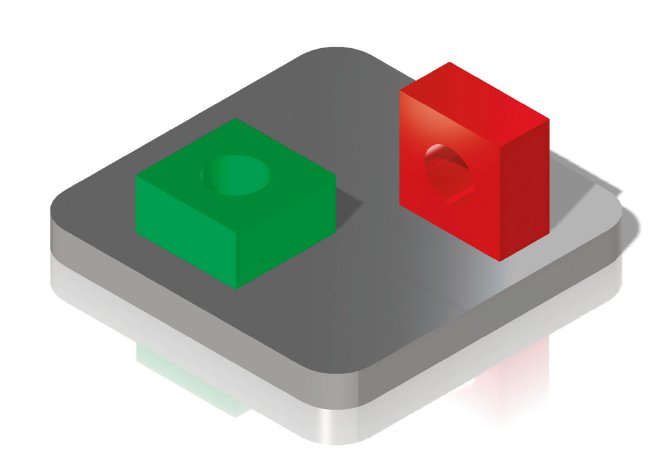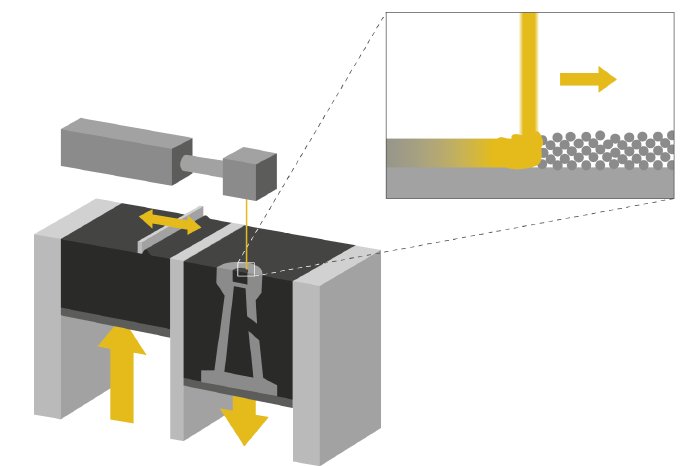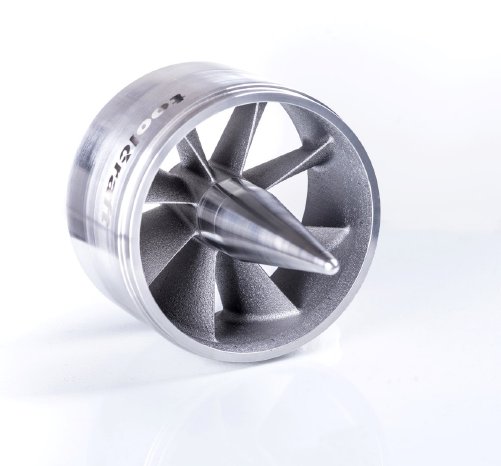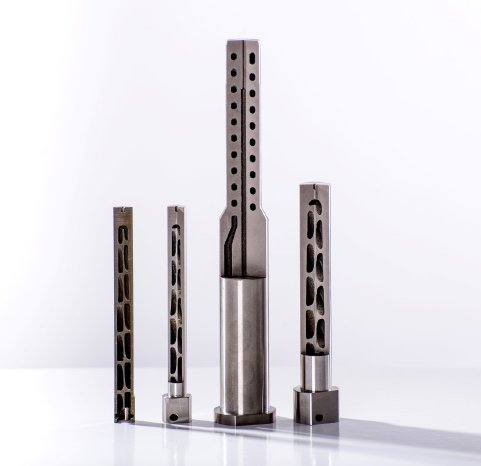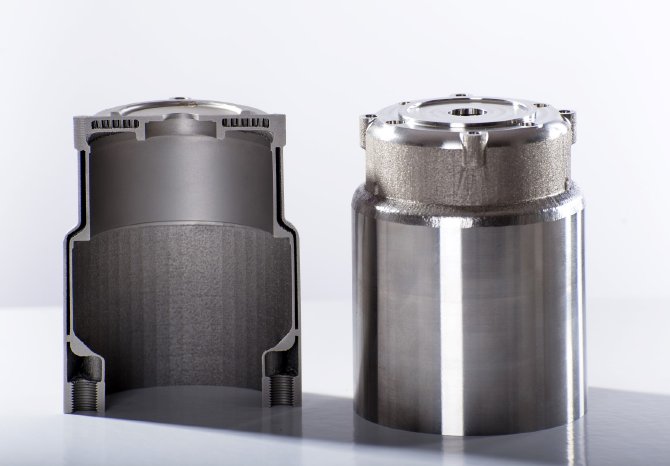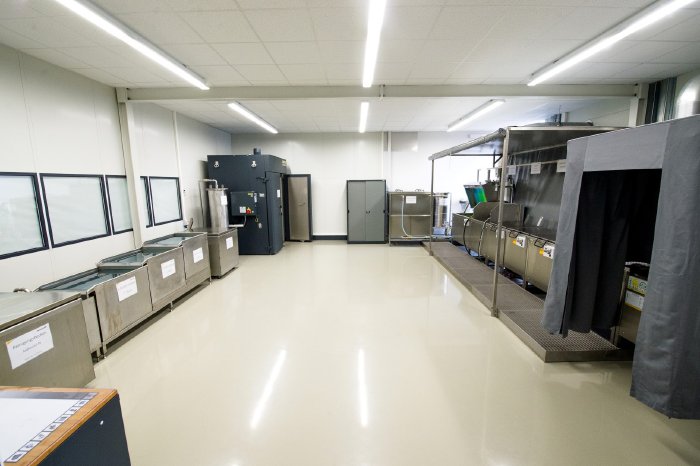Additive manufacturing is growing in popularity
Metal laser melting is enjoying growing interest. The process has made the leap from being used for rapid prototyping to developing into a recognised manufacturing technology. In the past, it was primarily used to produce prototypes but today, additive manufacturing is used in many industries for (small and medium) series manufacturing. This is why Toolcraft has invested twice in extending its suite of machines in the past year. Four laser melting machines are now available for manufacturing precision parts. 'The industrial metal laser melting market has a lot of potential. Machines, materials, processes, customers and suppliers continue to develop in exciting ways,' says Christoph Hauck, Managing Director of Toolcraft. The company has recently built up its portfolio in this direction and has invested in its own measurement technology. This means that Toolcraft can now test the quality of the powder as well as the properties of the material once a part has been manufactured.
Metal laser melting - making the near impossible possible
The innovative process has a number of clear benefits, ranging from the ability to manufacture complex geometries and manipulate materials that are difficult to machine, to the creation of components without the use of tools in very short periods of time and with extremely minimal waste of material. Lower piece costs, less warpage and reduced void formation make the manufacturing technology extremely effective. Prototypes, pilot series and small series can thus be executed quickly and efficiently. The limits on the potential for innovation are also boundless. As a research and development partner, Toolcraft can open up new perspectives with its manufacturing technology as well as market opportunities. In addition, the results are of an impressive quality and meet the demanding requirements of aerospace. In comparison with conventional manufacturing processes, the benefits are diverse. These are particularly apparent in the case of extremely complex parts that are needed quickly and in small numbers.
From the idea to the finished product
When an order is received, information is firstly exchanged. At this stage, Toolcraft makes a prior assessment of the feasibility of the design. If only 2D data is available, the in-house engineering team can translate this into 3D data. After further preparation of the data, the original mould is produced. Due to a special construction process in which the laser jumps back and forth between pre-determined melting points, the precision part is produced with a low amount of tension. Production takes place under a protective gas atmosphere depending on the material. In wire cutting, a wire precisely separates the part from the manufacturing plate.
Holistic solutions
Heat treatment following the full completion of the manufacturing process makes the final workpiece completely free of tension and ensures that it possesses the desired mechanical properties. Depending on the part, it may be necessary to carry out further refinement by milling or turning. If, for example, an extremely high level of precision is required, this can be achieved by further processing the surfaces. The final inspection and optical measuring are performed exclusively by qualified specialists, who can also use non-destructive surface testing equipment to check the part for cracks, overlaps, wrinkles, pores and a lack of fusion (see picture 1). As a partner for complete solutions, Toolcraft can reproduce the entire process chain from the idea to the finished part in-house.
Design guidelines
Contrary to widely held opinion, a number of design guidelines must be taken into consideration when constructing laser-melted parts. For example, larger drilled holes can only be made in the direction of construction without the need to use support structures. Diagrams 1-3 show simplified illustrations of the most important basic principles. Green indicates meltable constructions that do not require a support structure, while elements in red can only be manufactured if a support structure is made simultaneously. Overhangs under 45° require an external support underneath because the powder cannot be melted when the angle is so acute. Apertures under 45° also need a support structure. In this case, however, a review of the construction design is recommended. Ovals and overhangs greater than 45° are more suitable because they are able to support themselves, thus enabling the additional costs of a support structure to be avoided.
A reliable and equal partner
Since introducing the process, Toolcraft has been working with the machine manufacturer CONCEPT Laser GmbH. The collaboration between these two companies constitutes a perfect symbiosis that produces pioneering work. CONCEPT Laser contributes its existing results and experience to the development of the parameters of the metal laser melting process for different materials. Meanwhile, Toolcraft contributes strategies and expertise concerning the further processing of parts in machining processes. The company establishes guidelines in this regard, such as measurements and shapes to facilitate tensioning in order to meet customer requirements. The machines (see picture 2) offer a workspace of 250 mm x 250 mm x 280 mm in the x, y and z directions. They melt down layers measuring 20-80 μm in thickness at a speed of 2-20 cm³/h depending on the material. The laser has an output of 400 watts.
The process in detail
Diagram 4 illustrates the configuration of a part of laser melting equipment. The manufacturing plate is located in the workspace. The coater applies a thin layer of powder. The laser processes this at the pre-set melting points in a pre-determined order. In this way, a solidified layer is produced from the loose material. When the melting process is complete, a new layer of powder is applied from the stock of powder. The number of melted layers varies depending on the size of the part. When the job is completed, the majority of the unprocessed material remaining in the powder bed can be reused. Qualified specialists sift the powder and subject it to a strict quality control procedure.
Diverse base of materials
Metal laser melting, in combination with established core techniques such as turning and milling for materials that are difficult to machine, provides significant added value. This is why Toolcraft constantly works to improve the process as well as to extend its production capacity. When selecting materials, the company applies its expertise in materials and manufacturing to the needs of its customers. In principle, any material that can be welded can be processed. Toolcraft uses nickel-based alloys such as Inconel 718 and Inconel 625 as well as stainless steels such as 1.4404, 1.4828, 17-4PH and the hot-work steel 1.2709.
Invar 1.3912, Haynes 188 and Scalmalloy® added to the mix
Since 2013, Toolcraft has been working with the nickel-iron alloy Invar 1.3912, a material with a very low thermal expansion coefficient. It is used in the aerospace sectors, semiconductors and composite manufacturing. Another new material that the company has recently started to process is the cobalt-based alloy Haynes 188, which is a combination of cobalt, nickel, chromium and tungsten. The material is not only extremely heat-resistant but also resistant to oxidising environments up to 1,095 °C. Due to its properties, it is particularly suitable for use in the aerospace and motor sports industries. In this regard, it easily meets the high requirements of the production of engines as well as industrial gas turbines. Toolcraft has also begun to use Scalmalloy®, a high-strength aluminium alloy produced by the company Airbus APWorks. The material is corrosion-resistant with the specific strength of titanium at a simultaneously high ductility. In addition, it is more than twice as strong as the aluminium-silicon powder currently in use. Because of these properties, Scalmalloy® is ideal for high-performance applications in the aerospace and aviation industries, for automotive applications and for special machinery manufacturing.
An innovative process for almost all industries
Toolcraft creates pilot and small series for the automotive/motor sports sector, as well as engine, pump and vehicle components. The company also manufactures parts made of highly heat-resistant materials. For the aerospace, it produces housing parts and complex, thin-walled structures for gas turbines (see picture 3). For this purpose, the company primarily uses nickel-based alloys (Inconel 718, Inconel 625, Haynes 188), titanium alloys (TiAl6V4) and aviation steels (17-4PH) in powder form.
Example of tool and mould making
When manufacturing moulds, profiled pins are used as mould inserts that form contours. The rigidity and sturdiness of moulding pins in injection moulding and pressure casting contribute significantly to a successful end product. The metal laser melting process allows profiled pins with integrated cooling to be manufactured (see picture 4). Large cooling surfaces enable ideal heat transfer, which results in a maximum cooling effect at the front end of the cooling pin. In addition, the one-piece structure of the coiling and moulding pins ensures optimum sturdiness and rigidity of the moulding pin. Toolcraft also offers a special service where it conducts an efficiency and air-flow simulation before the start of production, taking into account construction design, air-flow behaviour, heat dissipation and a strength calculation. The tactile and/or optical measurement of laser-melted components ensures the highest quality. Finally, the workpiece components are also subjected to non-destructive testing.
Groundbreaking improvement
Up to 30% shorter cycle times are achievable through the use of laser- melted profiled pins with internal cooling. Without exaggeration, this number constitutes a groundbreaking improvement. These pins can also save customers the cost of injection-moulding or pressure casting equipment and tools in long-term projects. Metal laser melting also dramatically reduces the reject rate due to the optimised cooling effect significantly minimising faults in the parts produced and distinctly improving the quality of casting. A further opportunity to save costs is through the extension of maintenance cycles. In this way, the production of high-quality plastic and metal parts is no longer problematic and also provides a significant competitive advantage in addition to reduced costs.
Benefits also transferable to other industries
Thanks to its wide applicability, Toolcraft can transfer its experience from one industry to the requirements of other sectors. 'Laser melting is a perfect addition to our existing services, whether through the manufacture of complex parts which can neither be turned nor milled or through the reduction of cycle times in injection moulding and mould making using internally cooled moulding inserts,' says Christoph Hauck. In this way, the benefits of conformal cooling can also be transferred to other industries. This is used in the medical industry, for example. For this purpose, Toolcraft has built a cooling jacket with a sophisticated cooling system (see picture 5).
Visions of the future of 3D printing
What first began as rapid prototyping has very rapidly established itself as a recognised manufacturing technology. 'Many attempts are made to make laser melting more commercial. However, above all it requires years of experience in designing parts with regard to the behaviour of materials. This means that the use of qualified specialists will continue to be essential in the future,' concludes Christoph Hauck.
